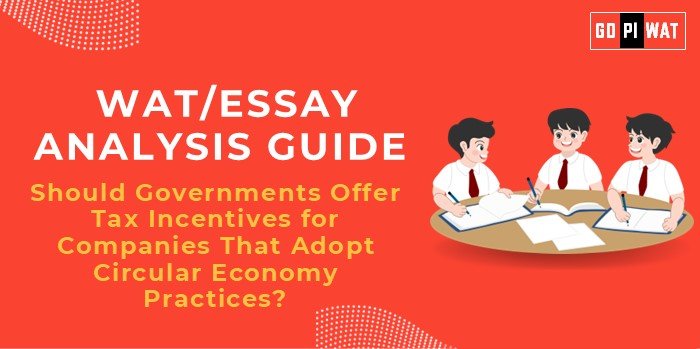📋 Written Ability Test (WAT)/Essay Analysis Guide: Should Governments Offer Tax Incentives for Companies That Adopt Circular Economy Practices?
🌍 Understanding the Topic’s Importance
Circular economy practices align with global sustainability goals like the SDGs, making them essential for reducing environmental degradation and fostering innovation.
🕒 Effective Planning and Writing
- Time Allocation:
- Reading & Planning: 5 minutes
- Writing: 20 minutes
- Reviewing: 5 minutes
✍️ Introduction Techniques for Essays
- Contrast Approach: “While traditional economies extract resources at an unsustainable rate, circular economies aim to regenerate materials and reduce waste. Tax incentives could accelerate this paradigm shift.”
- Solution-Based Approach: “Governments face the challenge of balancing economic growth with sustainability. Tax incentives for circular economies may hold the key.”
📖 Structuring the Essay Body
- Achievements: Highlight cost savings, innovation, and waste reduction.
- Challenges: Discuss infrastructure limitations, greenwashing risks, and policy complexities.
- Future Outlook: Propose policy frameworks, including monitoring mechanisms and public-private partnerships.
📄 Concluding Effectively
- Balanced Perspective Template: “Tax incentives, while effective in promoting circular economies, must be part of a larger policy framework to ensure long-term benefits and prevent misuse.”
- Global Comparison Template: “Drawing lessons from Sweden and the Netherlands, tax incentives must complement robust recycling infrastructure and public awareness campaigns.”
🔍 Analyzing Successes and Shortcomings
- Key Achievements: Cost efficiency, job creation, environmental impact.
- Ongoing Challenges: Lack of monitoring frameworks, initial capital barriers.
- Global Context: Reference successful European policies for benchmarking.
💡 Recommendations for Sustainable Progress
- Establish clear guidelines for tax benefits.
- Promote public awareness of circular economy benefits.
- Encourage private-sector innovation through subsidies and grants.
📝 Sample Short Essays
Balanced Perspective:
“Tax incentives can serve as catalysts for circular economies, but their effectiveness hinges on transparent policy implementation and monitoring.”
Solution-Oriented:
“To foster a sustainable economy, governments must leverage tax benefits while simultaneously investing in recycling infrastructure.”
Global Comparison:
“Sweden’s success in near-zero landfill waste demonstrates the potential of tax incentives combined with strong infrastructure and public education.”


